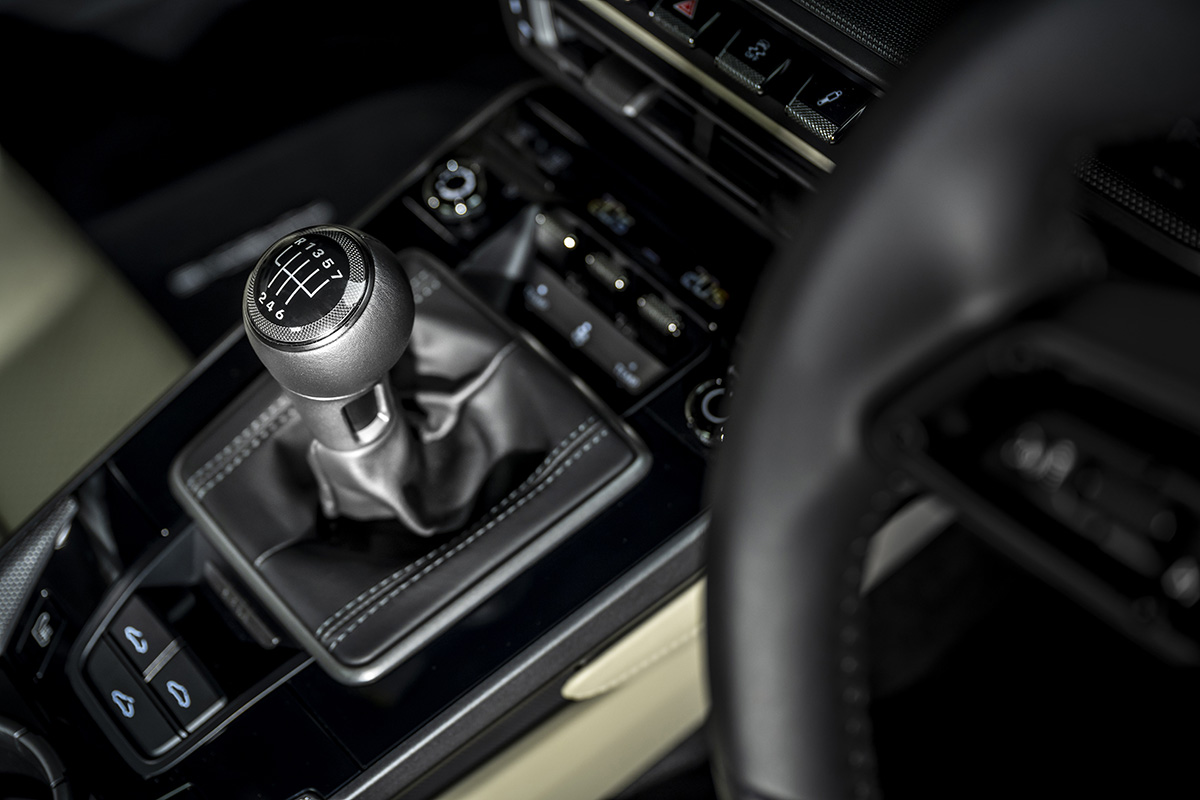It has been a long time coming, but at last a manual gearbox is available for the new 911 in the UK. It’s a timely arrival too, after sales of automatics officially overtook those of their three-pedal counterparts for the first time in our history this September. The manual is indeed an endangered species and no one knows that better than Porsche.
Perhaps this is why it has decided that the new seven-speed transmission, a no-cost option that comes with the Sport Chrono Package, will only be offered on S models, pitching it as a performance addition rather than a budgetary fallback. The simplest and most affordable Carrera, therefore, will only come with the more complex and traditionally more aspirational auto. The manual S will be the ‘driver’s choice’.
.jpg)
When you consider PDK’s popularity and its unarguable excellence, this makes total sense. Those opting for three pedals and manual labour will only be doing so because they want something extra from the driving experience. Having said that, the standard Carrera remains an astonishingly accomplished sports car and I, for one, would have loved to see a 992 in its simplest, most affordable form.
Nevertheless, Carrera S it is and what a combination that chassis, engine and seven-speed transmission make. When you lower yourself into the 992 cabin and place your elbow on the central arm rest, the gear stick falls perfectly to hand. Its action is sublime as always – a short, direct and deeply satisfying throw that has the capacity to be addictive before you’ve even turned the car on. After all the exposure to PDK and paddles, there is nothing quite like a modern Porsche H-gate.
.jpg)
A glance at the stats before driving reveals that at 1480kg the manually equipped Carrera S is some 35kg lighter than the same car with PDK. Its 0-62mph time is quoted as 4.2 seconds against 3.7 seconds, while the top speed of 191mph is unaffected.
Pulling away, the clutch pedal feels sensibly weighted, suggesting this would be an easy enough car to manage in traffic. But such practical thoughts vanish the minute you bury the throttle and reach for another gear. That increased level of engagement in the whole driving process, a much more tangible interaction with the drivetrain itself, is immediately apparent and rewarding. There’s no doubt that with every physical shift you are giving away performance and time to a PDK car, but the benefits outweigh the losses a hundredfold.
.jpg)
While a big part of this boils down to that involvement, there are other tangential gains. Today, especially in the UK, the opportunities to exploit even half of the 444bhp on tap from the Carrera S are few and far between, and a PDK gearbox only serves to exacerbate this frustrating fact. What the manual does better is, first, offer you driving satisfaction at any speed, with enough to keep you busy and engaged even if your perfect A-road is crawling with traffic.
But the second and more important attribute is one of interference. The sheer acceleration of the Carrera S, a car that can hold a candle to previous generation GT3s in terms of on-paper performance, is muted by the manual gearbox and its human operator. Those almost unbelievable acceleration figures from the PDK-equipped cars, perfectly repeatable time and again, are suddenly at the mercy of you and your limbs. Progress is slower and the means by which you achieve it markedly more fulfilling. When the car isn’t doing it for you, nailing a sequence of shifts is immensely satisfying.
.jpg)
On a less apparent and rather more technical front, as part of the latest Sport Chrono Package the manual Carrera S comes with a mechanical rear diff and Porsche Torque Vectoring (PTV), a system which varies the torque delivery to the rear wheels via minute automated braking intervention. Another nod to the driver-focused bias is a new automatic rev-match function which blips the throttle for you during downshifts. While many will regard this as heresy, the system is a delight to experience and one that will also serve to protect engine and gearbox. And it can be switched off should you wish to roll out the old-school heel and toe.
The only criticism I can muster towards the manual Carrera S is the perceived quality and feel in the hand of the actual shifter. The 991’s gearstick was made from a piece of milled aluminium shrouded in part by leather or Alcantara in the GT cars. It felt expensive and probably was. The 992’s offering, with its more simple and traditional pattern markings beneath clear plastic instead of etched into an aluminium dome, looks and feels oddly cheap considering the stunning level of design and execution of the rest of the cabin. It’s a small thing but those principal touch points are so vital to the way we react to our cars that it feels like a big miss. All the same, it’s not really about how the shifter looks but what it does, and that is revelatory.

It’s horses for courses when it comes to transmission options, of course, and becoming evangelical about the manual threatens to do an injustice to the PDK. The latter is still the very finest dual clutch system available, and its ease of use and shatteringly quick, seamless shifting makes it a very difficult thing to dismiss. In the hypothetical situation five years hence when we’re all leafing through the classifieds on the hunt for a second-hand 992, the presence of PDK should not be a red line. But the manual offers that little extra something. A purer, more direct connection to your 911, and to the very essence of Porsche.